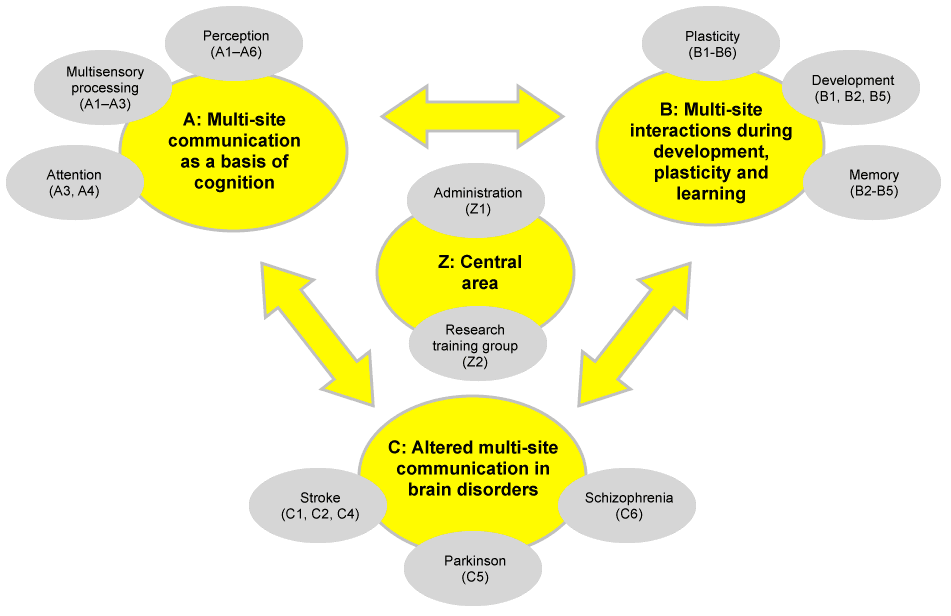PROJECTS
THEMATIC AREAS
The projects of the Collaborative Research Centre address three key issues regarding the processing and dynamics in distributed networks. We focus on, first, characterising multi-site neuronal communication that underlies cognitive functions; second, studying changes of multi-site interactions during development, plasticity and learning; and third, investigating alterations of multi-site communication in brain disorders.These three key issues map onto the three thematic areas of the Collaborative Research Centre:

A. MULTI-SITE COMMUNICATION AS A BASIS OF COGNITION
Projects in thematic area A investigate multi-site interactions in the nervous system subserving visual, auditory, tactile and pain perception, multisensory and sensorimotor integration, attention, as well as emotion and reward processing. Project A1 aims at modelling the large scale dynamics in the ferret and the human brain, based on data from the respective experimental projects. Projects A2 and A3 address multisensory interactions with a focus on visual-auditory and visual-tactile integration, using complementary approaches in animal and human studies. Projects A4, A5 and A6 have a common focus on multi-site interactions in pain perception, focussing on modulation of pain processing by attentional and contextual factors (A4), at network mechanisms of sensitisation and habituation (A5) and at the effects of contextual manipulation of anxiety and reward value (A6).
B. MULTI-SITE INTERACTIONS DURING DEVELOPMENT, PLASTICITY AND LEARNING
Projects in thematic area B focus on changes of network interactions ensuing from alterations in brain development. Moreover, projects in this thematic area address multi-site communication in networks underlying memory and learning. Projects B1 and B2 investigate sensorimotor and multisensory interactions in sighted and blind humans. Projects B3 and B4 investigate the potential role of oscillatory activity and coherence in memory-related circuits. Project B5 has a developmental focus, studying abnormal patterns of functional coupling in neonatal animals as a basis for cognitive and behavioural disturbances. The focus of project B6 is on modelling of developmental plasticity and compensatory plasticity after network lesions.
C. ALTERED MULTI-SITE COMMUNICATION IN BRAIN DISORDERS
Thematic area C focuses on disorders that are associated with pathological alteration in neuronal interactions. The clinical conditions addressed in the projects of this thematic area include stroke, Parkinson’s disease and schizophrenia. Projects C1, C2 and C4 involve studies on patients suffering from stroke, focussing on the analysis of interactions between cortical motor regions and on mechanisms of large-scale functional regeneration and reorganisation. In these projects, structural and functional coupling are investigated in a complementary manner in the same patient groups. Project C5 addresses alterations of multi-site interactions and of structural connectivity between cortical motor regions in patients with a monogenetic form of Parkinson’s disease. Project C6 investigates changes in multi-site interactions occurring in patients with schizophrenia.
Funded by Deutsche Forschungsgemeinschaft
1. funding period: July 1, 2011 - June 30, 2015
2. funding period: July 1, 2015 - June 30, 2019
3. funding period: July 1, 2019 - June 30, 2023

